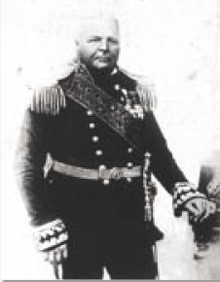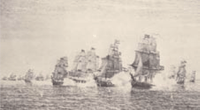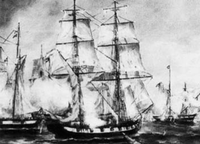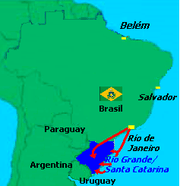Frederico Mariath

Frederico Mariath was an admiral in the Imperial Brazilian Navy who participated in the Cisplatine War and some of Brazil's internal conflicts of the early 19th century.
Major actions
Cisplatine War
Mariath was put in command of a small squadron of four vessels stationed near Colonia del Sacramento. His mission was to defend the local fortifications, in coordination with the garrison of approximately 1,500 men under the command of Brigadier Manuel Jorge Rodrigues.
On February 26, 1826, an Argentine squadron under the command of William Brown ran the blockade and appeared to challenge the garrison at Colonia. The men and guns of the Brazilian vessels had been landed to reinforce the fort, and the resulting confrontation was and inconclusive cannon duel, as a ground attack by troops from the Banda Oriental failed to materialize.
After repelling this initial attack, Mariath asked for assistance from Montevideo, but the commanding Vice Admiral Rodrigo Lobo refused. On the first of March Brown launched a second attack. The night assault, supported by gunboats, was repelled after a bloody combat in which the Argentine troops suffered heavy losses but succeeded in destroying two Brazilian ships.

Later that year, he was put in command of a squadron consisting of the brig Caboclo, the corvette Maceió, and the frigate Nichteroy. He distinguished himself in the defense of the frigate Imperatriz on April 26, in the battle of Ortiz Bank on 3 May, and the battle of Lara-Quilmes on 29 and 30 June. During this last battle, the massed fire of a number of Brazilian vessels succeeded in knocking the major Argentine ship the 25 de Mayo out of action.
On 12 May in Montevideo, Admiral Rodrigo Pinto Guedes assumed command of Brazilian naval forces operating in the Rio de la Plata sector, often called the Escuadra del Sur (Southern Squadron). He decided to adopt a more aggressive strategy and divide his fleet in three parts to accomplish it. He put Captain James Norton in command of a squadron (the Division Bloqueo) whose mission it was to definitively blockade the strategic port of Buenos Aires. Another squadron (the Third Division), led by Jacinto Sena Pereira, was ordered to control the Rio Uruguay and thereby cut lines of supply and communication between the Argentines and their expeditionary forces in the Banda Oriental. Mariath was put in charge of the reserve squadron, based at Colonia del Sacramento.
Battle of Juncal
Principle article: Battle of Juncal
The Argentine commander Brown soon began making plans to confront the Third Division. Fighting with a smaller force, he had to devise a way to keep the Brazilian squadrons from supporting each other, as any combination of squadrons would greatly outnumber his own fleet. His solution was to build a fort on Isla Martín García, at the mouth of the Rio Uruguay, with the purpose of protecting his flank as he chased the Third Division up the river as well as preventing the Mariath Division from reinforcing the Third.

Mariath made a timid attempt to bypass the fort on its less defended side, but the danger of sand banks, the existence of a mobile battery in the fort that could be moved to cover the alternate approach, as well as the advance of the Argentine fleet, resulted in retreat.
Thus on February 8, 1827, when the Third Division began to descend the river to link up with Mariath, they found instead Brown waiting for them. In the ensuing Battle of Juncal the Brazilian fleet was completely destroyed, with only 2 of 17 vessels escaping. Although Mariath was within earshot of the cannon fire, he judged an attempt to force his way past the fortifications to be too risky. He instead engaged in an extended gun duel with the fort, an ineffectual action which was eventually disrupted by a storm.
On February 9, while the Third Division was pursued and finished off by Brown's squadron, the Mariath Division remained at a distance without intervening. The next day Mariath decided to retreat in the direction of Colonia del Sacramento, where he arrived the next week.
Civil Wars

In 1835 a rebellion broke out in the town of Cabanagem, Pará. The rebels succeeded in taking the provincial capital, Belém, in response to which the government sent a combined naval and land force. Although the government forces took the capital, the rebellion continued in the interior and the rebels eventually retook the city that August.
Commander Mariath was sent as a replacement for the expedition's commander of naval forces, John Taylor. The navy proceeded to blockade the port, bombard rebel positions, land army troops, and conduct riverine patrols. The rebels were pressed hard and eventually abandoned the city and retreated again to the interior, where they would continue to fight until 1840.

1835 was also the year that a republican uprising broke out in southern Brazil, in particular the state of Río Grande do Sul. This war was known as the Ragamuffin War.
In 1838 the Imperial government named Mariath as military commander in the province of Santa Catarina, with the mission to confront the rebels. (The revolution had extended to this province in the form of the República Catarinense.)
On November 15, in command of a fleet of some 13 vessels carrying 33 guns and approximately 1000 men, Mariath defeated the republican forces under Giuseppe Garibaldi in the Barra de Laguna.
References
Notes
Biography
- Carranza, Angel Justiniano, "Campañas Navales de la República Argentina", Talleres de Guillermo Kraft Ltda., Buenos Aires, 2º edición, 1962
- Arguindeguy, Pablo E. CL, y Rodríguez, Horacio CL; "Buques de la Armada Argentina 1810-1852 sus comandos y operaciones", Buenos Aires, Instituto Nacional Browniano, 1999
- Vale, Brian, Una guerra entre ingleses, Instituto De Publicaciones Navales, 2005, ISBN 950-899-057-0
External links
- Sitio oficial de la Armada del Brasil (Portuguese)
- Navíos de Guerra, en naval.com.br , (Portuguese)
- Navíos de Guerra Brasileiros (Portuguese)
- Cronología del Almirante Brown (Spanish)
- Navíos de las Provincias Unidas del Río de la Plata (Spanish)
- Historical Handbook of World Navies
- Navíos de Guerra
- Historia y Arqueologia Marítima
- Sitio oficial de la Armada de la República Argentina (ARA) (Spanish)
- Fuerzas Navales, portal naval argentino (Spanish)
| ||||||||||||||||||||||||||||
.svg.png)